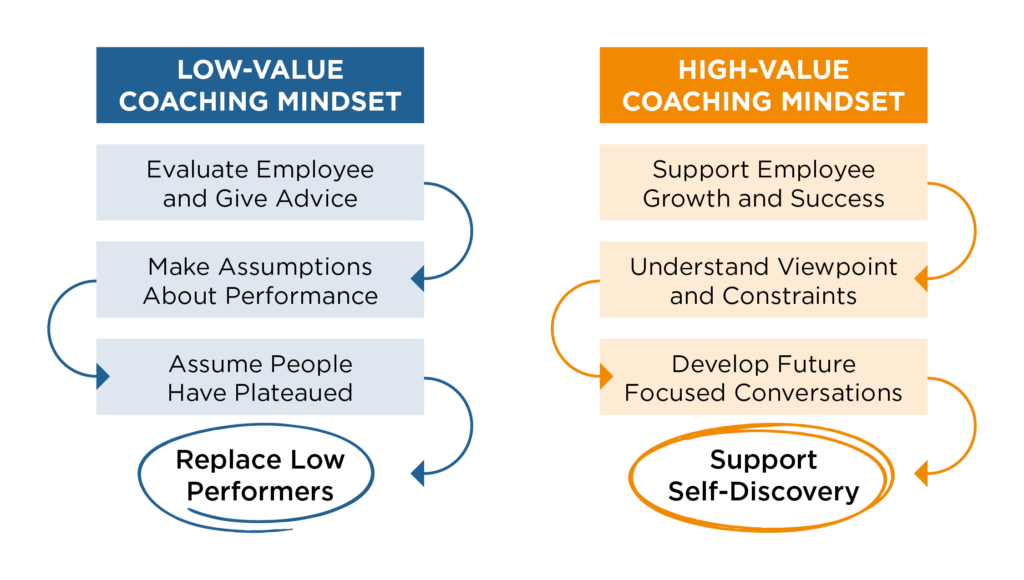Why Your Company’s Coaching Efforts Are Failing

With the stakes higher than ever, organizations recognize that coaching plays a critical role in engaging employees, reducing turnover and improving overall business performance. So why are most of their coaching efforts failing?
In the face of competing business priorities, increased workloads and broader responsibilities, every leader is feeling the pressure. And with the war for talent at heights rarely seen before, how do they respond to these demands?
Organizations are feeling the crunch of mass employee exoduses and demands for greater flexibility, more feedback and meaning in their work. For years coaching has been seen as a critical aspect of an employee retention strategy. And the impact on companies’ bottom line has been well-documented. But coaching often still doesn’t happen… Even our own research of more than 200 leaders across industries found that 76% said coaching was a critical component of their employee development strategy; yet just as many felt too little coaching was being provided. The gap can often be attributed to a lack of clarity and buy-in on the part of leaders about their responsibility as coaches and a failure to commit to the type of coaching conversations that will bring out the best in their people.
Coaching efforts must focus on bringing out the unique talents and strengths each employee possesses. But coaching can’t be a cookie-cutter approach and it can’t be done merely in ways that are comfortable for the manager. No two coaching conversations should be alike because no two of your people are alike.
When a coaching culture is absent, well-intended managers can often end up reverting to piling more onto what they see as their “most reliable” employees. But over time, overworking these high performers can actually backfire- they become less responsive because their above-average efforts are typically rewarded simply with an even more demanding workload. The result? Burnout goes way up while engagement and productivity go way down. And they may even eventually exit the organization. Turnover—of your top talent, no less—is a very real threat lying in wait and the cost can be more than you think. The sad part is it’s so often self-inflicted.
What about the rest of the team? In research we conducted, 31% of managers said that their role is to pick up the slack for their low performers. In essence, they’re enabling weakness instead of committing to building strengths, because employees are left with the perception that it’s OK to underperform (or at the very least, the organization will tolerate it). And a not-so-subtle message might be getting sent that their leaders have given up on them.
THE LAW OF LIMITED PERFORMANCE
Whether it’s a lack of skills, awareness or commitment to coaching, many managers today are struggling to improve their team’s skills and behaviors. When their employees fail to achieve desired results, they start to believe their people have plateaued.
What happens is an almost self-perpetuating loop that puts a cap on potential and performance. Managers unwittingly send a message that an employee’s current level of performance is all they are capable of, so employees adjust accordingly. We call this “The Law of Limited Performance.” The result? Both reinforce what the other believes. But there is hope…
HOW COACHING EFFORTS CAN BREAK THE LAW OF LIMITED PERFORMANCE
Great leaders and managers define coaching as expanding an employee’s personal belief boundaries, those limits that keep them from improving their performance. These boundaries are usually deeply embedded and can cause employees to “self-correct” and fail when taking on new challenges.
To successfully break this pattern and get people off plateaus, managers must do two things.
Understand the belief boundaries inhibiting employee success
Managers can increase employee confidence to step outside their belief boundaries by seeing more in the employee than they themselves might see. Understand that no matter how much someone knows (intellectually) what they’re supposed to do, negative self-talk can work against them and cause negative results. A good coach’s job is to help people recognize this self-talk as just talk and dig deeper to show what they’re really capable of.
Use coaching techniques that help employees set (and achieve) goals outside their comfort zone
Great coaching conversations and techniques that ignite an employee’s ability to “own” their own breakthroughs start with managers who are committed and know how to:
- Ask open ended questions.
- Listen for perceived limitations and current belief boundaries.
- Set incremental goals just beyond those boundaries.
- Use praise to reinforce success.
- Treat failure as learning.
COACHING EFFORTS THAT EXPAND BELIEF BOUNDARIES
Coaching conversations should be much more about managers listening than telling. With the right focus, managers will be more effective in how they understand an employee’s belief boundaries, be able to increase their ownership of developing solutions to overcome challenges, and appropriately challenge them to next levels of performance.
Stay curious about the employee’s perspective
Asking open-ended questions about their goals (not yours…), challenges and beliefs will create two-way dialogue and eliminate the manager’s urge to have all the answers. Actively listen to fully understand the employee’s viewpoint. Observe and show appreciation for how employees are stepping outside their comfort zone by focusing more on activities than short-term results.
Boost employee engagement and creativity
Managers can empower employees by allowing them to leverage their “why” to figure out their “how.” Solicit ideas for new options to their perceived limitations and invite creative thinking to solve challenges.Providing positive reinforcement of the value the employee brings creates a supportive environment where they’re no longer fearful of taking risks and trying new approaches. Offering praise increases the likelihood employees will use new skills and behaviors.
Translate new skills and behaviors into actionable results
The best way to start seeing new behaviors take hold is by linking them to how they deliver organizational value. By promoting commitments that are Specific, Measurable, Actionable, Realistic and Time-Bound (or SMART) and recognizing progress frequently while providing course corrections as needed, people will shift away from fear of making mistakes and instead view their daily tasks as learning opportunities.
MANAGEMENT MINDSETS: SETTING THE STAGE FOR BREAKING THE LAW OF LIMITED PERFORMANCE
Creating an environment that fosters new behaviors, attitudes and skills takes more than just following a prescribed coaching process. A manager’s mindset directly influences the quality of his or her coaching efforts—either creating an environment where coaching causes anxiety or is feared or a safe and trusting one where it is eagerly accepted and welcomed.
The chart below illustrates two very different mindsets of how managers view coaching, with two very different outcomes. Replacing low performers because a manager believes an employee has plateaued and will never improve is a low-value outcome to a coaching conversation. Supporting self-discovery is a high-value coaching conversation outcome, one that leads both under-performing and top-performing employees to become more intrinsically motivated to raise their performance and fulfill the organization’s mission and business objectives.

With the right mindset, managers will see a far greater return on their coaching efforts and have higher value coaching conversations that support two-way communication and collaborative problem solving. Again, coaching conversations are more about managers listening than telling.
Managers set the stage for success by clearly communicating their role as a coach:
“I really want this to be your best year yet. Let’s talk about the goals you want to achieve.”
“I’d like to understand the challenges from your perspective and hear any ideas you have for what we should do.”
“I’m eager to hear your thoughts on how we can move the needle on this.”
By shifting the manager’s mindset from “mistake catcher” and “problem solver” and simply reviewing tasks and to-do lists to a coaching leader and collaborator that instills confidence and a sense of ownership, you’ll not only help your people realize their full potential but ensure they stay with you longer and even become that next generation of leaders that every company needs.
If you would like to talk about what great coaching could look like in your organization, we’d be glad to talk. Contact us today.

Chief Sales Officer
Related Blog Posts



